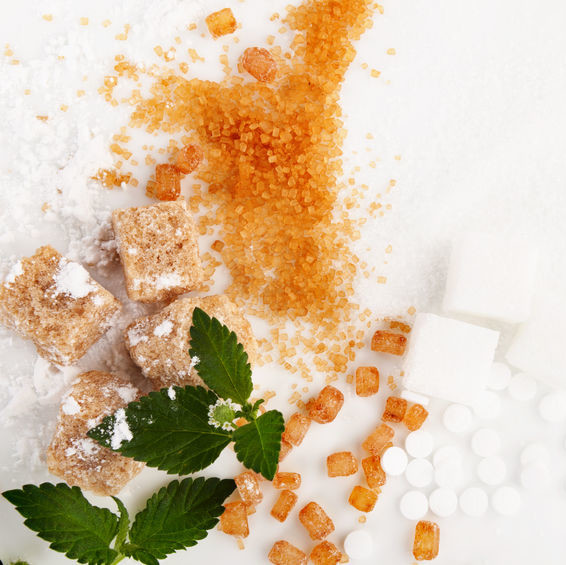Sweeteners
What are Sweeteners?
Sweeteners are carbohydrates are characterized by their sweet taste. The most common ones in baking are mono and disaccharides.
These ingredients are essential components of baked goods. They are added to yeast-leavened products, as well as to chemically-leavened sweet goods like batter cakes and cookies. Although, then they are used in larger quantities.
- Sucrose
- Lactose
- Crystalline glucose
- Brown sugar
- Molasses
- Liquid sugar
- Invert sugar syrup
- Honey
- Maple sugar
- Glucose or corn syrup
- High fructose corn syrup
- High-intensity sweeteners
- Sugar alcohols or polyols
Origin
Sweeteners are widely found in nature as components of biomass. They can also be produced from plant sources that are rich in starch. They are naturally found in fruits, stevioside leaves, milk, sugar cane, sugar beet, honey, maple tree, and in smaller amounts in cereals and grains.1
Function
Some of the functions of these ingredients are:2,3
- Sweetening
- Tenderizing
- Batter aeration (crystallized sugars)
- Fermentation control through osmotic pressure
- Yeast nutrient / food
- Bulking agents (body)
- Flavoring agents (molasses, honey, malt, maple sugar)
- Browning or crust coloring agents
- Humectants
- Texture builders
- Shelf‐life extenders by lowering water activity
They can be classified according to their caloric content as:
- Nutritive or caloric sweeteners
- Non-nutritive or high-intensity sweeteners
Nutritive options can be either mono or disaccharides, or a mixture of both:
| Monosaccharides (simple sugars) | Disaccharides (2 simple sugars, bound by glycosidic linkage) |
|
|
Non-nutritive sweeteners are zero or low-calorie sweeteners, however their usage in baking is limited.
Commercial production
The following table summarizes the production processes used to manufacture different ingredients:1,3,4,5
| Raw material or source | Process | Product obtained |
| Sugarcane, sugar beets | Sugar refining |
|
| Sucrose |
|
|
| Starch from cereals, tubers and/or roots |
|
|
| Milk | Separation, concentration and drying | Lactose |
| Nectar of plant blossoms, and honey bees | Natural production process | Honey |
| Maple tree (Acer saccharum) | Concentration of sugars in the sap produced by maple tree | Maple sugar |
| Sucrose and other sugars | Chemical reactions | High intensity sweeteners |
| Monosaccharides and starch sources | Enzymatic conversion and further reduction reaction (hydrogenation) | Polyols |
Application
The type and amount of a given sweetener are selected based on the its contribution to doughs, batters or finished products, namely:
- Fermentability: Essential for yeasted products
- Sweetness level or relative sweetness
- Total solids and moisture content: liquid (pumpable), or dry sweeteners. This is critical for chemically-leavened batter-based products like cakes.
These criteria must be properly stated in a sweetener’s spec sheet.
Nutrition and health
Consumption of excessive amounts of sugars in the diet may lead to metabolic imbalance. Of special importance is increased risk of chronic diseases such as obesity, diabetes, and cardiovascular disease.6
References
- Alexander, R.J. “Production and Description.” Sweeteners: Nutritive, Eagan Press Handbook Series, AACC International, Inc., 1998, pp. 17–29.
- Indrani, D., and Venkateswara Rao, G. “Functions of Ingredients in the Baking of Sweet Goods.” Food Engineering Aspects of Baking Sweet Goods, CRC Press, Taylor & Francis Group, LLC, 2008, pp. 31–35.
- Mariotti, M., and Lucisano, M. “Sugar and Sweeteners.” Bakery Products Science and Technology, 2nd Edition, John Wiley & Sons, Ltd, 2014, pp. 199–220.
- Nelson, A.L. “Overview.” Sweeteners: Alternative, Eagan Press Handbook Series, AACC International, Inc., 1998, pp. 1–15.
- Clarke, M.A. “Non-sucrose Carbohydrates.” Handbook of Sweeteners, Springer Science+Business Media, LLC, 1991, pp. 52–71.
- BeMiller, J.N. “Carbohydrate Nutrition, Dietary Fiber, Bulking Agents, and Fat Mimetics.” Carbohydrate Chemistry for Food Scientists, 3rd Edition, Published by Elsevier Inc. in cooperation with AACC International., 2019, pp. 325–329.


